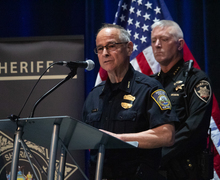SU community shares concerns about changes to sexual assault services at third listening meeting
In order for the Syracuse University student body to heal following the closing of the Advocacy Center, there must be a sense of community established in the Counseling Center and campuswide.
This was a strong sentiment expressed by groups of faculty, students and some members of Chancellor Kent Syverud’s Workgroup on Sexual Violence Prevention, Education and Advocacy at a listening meeting Monday afternoon.
The meeting was held in the Schine Student Center and involved small group discussions on areas such as issues and concerns about sexual violence services on campus, gaps in services and campus culture in relation to sexual and relationship violence. Graduate students from the Program for the Advancement of Research on Conflict and Collaboration helped lead the six groups by taking notes on ideas and then sharing them when the groups reconvened. Only a handful of undergraduate students were in attendance at Monday’s meeting.
The Advocacy Center was designed to welcome victims of sexual and relationship violence because it allowed students to interact with counselors on a more casual basis, said Vicky Wang, a member of the chancellor’s work group and a graduate student in the earth science program.
But the Counseling Center is not designed to be welcoming. It requires students to go through many formalities to speak with a counselor, such as scheduling an appointment, and the waiting room doesn’t encourage connection between people, she said.
“It’s not very welcoming for people to drop in, whereas the Advocacy Center space was deliberately arranged to be welcoming,” Wang said. “I think that’s very important.”
Victims of sexual and relationship violence may also hesitate to use the Counseling Center because of its location. During the campus culture discussion, one group expressed concern over the center’s location on Walnut Avenue being close to fraternities and out in the open, which could make victims feel “traumatized or re-victimized.”
Discussions of community and welcoming also need to extend beyond the services offered in the Counseling Center. Much of the decision making for the future of sexual assault resources has been limited to an administrative or faculty perspective, said Keagan Kirk-Singer, a fifth-year student in the industrial and interaction design program.
The campus is also divided in how it wants to deal with the resources, she said, adding that they should be working as a community instead. “If they really want to make changes and they really want this to be successful, they need to listen to the student body,” Kirk-Singer said.
Kirk-Singer and Shelby Zink, also a fifth-year student in the industrial and interaction design program, expressed frustration that only six undergraduate students showed up to the listening meeting. The turnout was in stark contrast to the group of 75 students and faculty that gathered for the Advocacy Center rally on Sept. 18.
Zink said the lack of attendance from undergraduate students could be due to poor advertising. Because the dialogue is dominated by faculty and administration, much of the advertising for the Counseling Center as well as other initiatives fell flat, she said.
Zink pointed to the Counseling Center stickers in bathroom stalls and the survey posted by the chancellor’s work group online as two areas that need to be better designed and advertised for students.
Groups were given 15 minutes per each category of issues and concerns to list their thoughts on the topic. Many of the groups’ thoughts echoed one another, such as:
—Students underreporting incidences of sexual and relationship violence because they don’t have faith in the system.
—Students still don’t know what the changes are.
—Discrepancies between official and student narratives.
—Little knowledge of who the Sexual and Relationship Violence Response Team is.
—A lack of apology from the administration and limited involvement from Chancellor Kent Syverud.
—Keeping the Counseling Center open beyond the “typical 9–5 hours.”
—Establishing student ambassadors to create a support system for victims.
—Recognizing there are connections between athletic culture, fraternity culture and rape culture.
Before the meeting closed, Rebecca Reed Kantrowitz, senior vice president and dean of Student Affairs, explained where she believes the notes gathered during the meeting should be shared. The notes will be given to the chancellor’s work group to help inform its report, the Sexual and Relationship Violence Coordination Team and the communications manager in the Office of Student Affairs. They should also be shared with groups working on the Campus Master Plan and the Strategic Plan Steering Committee, she said.
Chase Catalano, director of the LGBT Resource Center, also spoke about the future of the chancellor’s work group. Catalano said he is “well aware” that the group has mostly spoken with administrators so far, but that moving forward, it will focus on speaking with survivors of sexual and relationship violence.
The biggest challenge in engaging with survivors is making sure they don’t have to revisit their experiences by communicating with the work group, he said.
“We need to talk to students who are survivors because that’s who is directly impacted by the services,” Catalano said.
Published on October 28, 2014 at 12:07 am
Contact Annie: [email protected]




